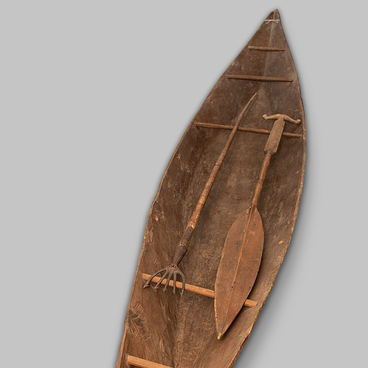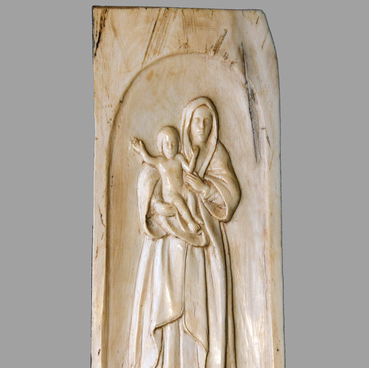Gaiters are the national Khanty women’s shoes. The exhibit came to the funds from forwarding collections of the Tobolsk Provincial Museum on the Ob in Uryevskiye Yurty of the Lokosovskaya Administration of the Surgut District for the first West-Siberian exhibition, which opened in Omsk on 15 June 1911.
Researchers attribute gaiters to a special plunger-shaped type of footwear of indigenous Northern peoples. In this case, the shoes consisted of a piston sole and a top sewn thereto. Tobolsk gaiters are hand-sewn with sinew thread of rawhide that is durable skin taken from the legs of deer. The sole was made of sheared deerskin with wool inside for extra warmth. A wide saddle is sewn to it with a small seam. The top was cut from a single piece of leather and sewn to the saddle. The craftswoman decorated the saddle with an ornament sewn from thin strips of rawhide and deer hair, and also placed an ornament made of white and dark brown leather between the top and the lower part. This geometric pattern is called ‘sable’.
Rawhide is a rare leather material. The process of obtaining it in the Far North has traditionally been difficult. The removed skin of a deer intended for rawhide dressing was laid out on the snow with its hair down and carefully straightened. After that, the frozen skin was cleaned of hide scrapings, such as clots, films, and fat. Then the raw skin was tightly rolled up and placed in a warm place for several days. Under the influence of heat, the enzymes in the skin destroyed the hair follicles, which facilitated subsequent processing.
After two or three days, the skin was unwrapped, and the wool was removed with a scraper. If the action of the enzymes was not enough, the skin was smeared with fish entrails and rolled up again. After that, the wool was scraped out again. After the wet skin was dried in the wind, then it was thickly smeared with fish oil, frozen yogurt, or buttermilk, i.e. the liquid left after churning the oil.
At the next stage, the skin was kneaded for several days on a special machine and sanded using special tools. In order for the rawhide to become waterproof, it was ‘smoked’, that is, hung on a frame over a weakly smoldering fire made of logs of resinous wood. After that, it was painted with willow and birch bark, ochre, and white clay. Such gaiters were used by women as summer shoes. In winter, they were worn only when women had to stay in the house for a long time.
Researchers attribute gaiters to a special plunger-shaped type of footwear of indigenous Northern peoples. In this case, the shoes consisted of a piston sole and a top sewn thereto. Tobolsk gaiters are hand-sewn with sinew thread of rawhide that is durable skin taken from the legs of deer. The sole was made of sheared deerskin with wool inside for extra warmth. A wide saddle is sewn to it with a small seam. The top was cut from a single piece of leather and sewn to the saddle. The craftswoman decorated the saddle with an ornament sewn from thin strips of rawhide and deer hair, and also placed an ornament made of white and dark brown leather between the top and the lower part. This geometric pattern is called ‘sable’.
Rawhide is a rare leather material. The process of obtaining it in the Far North has traditionally been difficult. The removed skin of a deer intended for rawhide dressing was laid out on the snow with its hair down and carefully straightened. After that, the frozen skin was cleaned of hide scrapings, such as clots, films, and fat. Then the raw skin was tightly rolled up and placed in a warm place for several days. Under the influence of heat, the enzymes in the skin destroyed the hair follicles, which facilitated subsequent processing.
After two or three days, the skin was unwrapped, and the wool was removed with a scraper. If the action of the enzymes was not enough, the skin was smeared with fish entrails and rolled up again. After that, the wool was scraped out again. After the wet skin was dried in the wind, then it was thickly smeared with fish oil, frozen yogurt, or buttermilk, i.e. the liquid left after churning the oil.
At the next stage, the skin was kneaded for several days on a special machine and sanded using special tools. In order for the rawhide to become waterproof, it was ‘smoked’, that is, hung on a frame over a weakly smoldering fire made of logs of resinous wood. After that, it was painted with willow and birch bark, ochre, and white clay. Such gaiters were used by women as summer shoes. In winter, they were worn only when women had to stay in the house for a long time.

